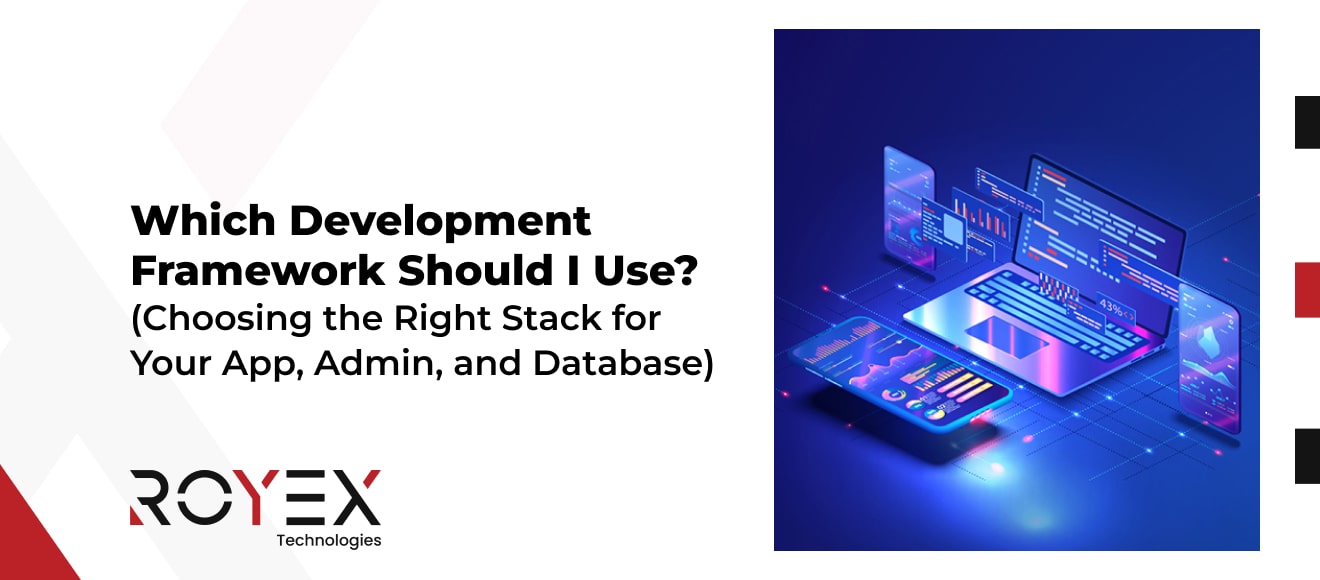
Which Development Framework Should I Use? (Choosing the Right Stack for Your App, Admin, and Database)
Series note: Based on common questions asked by our customers before developing mobile apps, we have listed most of the questions and answers in detail for each topic. This article is part of our series “Mobile App Journey: Things You Must Know.”
If you want a pragmatic, future-proof stack that balances speed, cost, and scalability, here’s a battle-tested baseline we recommend for most greenfield projects:
-
Mobile apps: Flutter (primary) or React Native when you already have React talent; go Swift (iOS) or Kotlin (Android) when you need absolute native control.
-
Admin/Back-office (web): ASP.NET Core for the admin portal and APIs (fast, secure, cloud-ready).
-
Database: Microsoft SQL Server (MSSQL) for transactional workloads needing reliability, strong tooling, and reporting.
Below, we unpack why, where each option shines, trade-offs, real-world selection criteria, and how this maps to different app types and team profiles—along with fresh statistics to keep your decisions grounded.
Why Stack Choices Matter (And How to Think About Them)
Your tech stack decides not just how you build, but what you can afford to build—and maintain. It affects:
-
Time-to-market: Developer productivity, available libraries
-
Total cost of ownership: Maintenance, cloud costs, hiring
-
User experience: UI smoothness, startup time, battery
-
Risk & longevity: Ecosystem maturity, vendor lock-in
A simple mental model:
-
Start from the user and business job. Is the app content-first? Sensor-heavy? Real-time?
-
Map constraints: Device fragmentation, offline needs, compliance, SLA.
-
Pick smallest-viable tech that delivers the experience—then scale up only when needed.
Market Context You Should Know
-
Android dominates global handset share, with ~74% Android vs ~26% iOS (Aug 2024–Aug 2025). That means most consumer apps must support both platforms from day one—or have a plan to get there quickly. (StatCounter Global Stats)
-
On Android, Kotlin is the recommended, “Kotlin-first” language and is now used by the majority of pro Android devs—useful when you go fully native or need custom modules. (Kotlin)
-
For iOS, Swift is Apple’s modern, safe, high-performance language and the default for serious native apps. (Apple Developer)
-
For the admin/API tier, ASP.NET Core is a cross-platform, high-performance framework used to build fast, secure, cloud-ready services—great for dashboards and admin UIs. In independent benchmarks, ASP.NET Core consistently lands among the top performers. (Microsoft Learn)
-
On databases, Microsoft SQL Server ranks #3 overall in DB-Engines’ popularity index—reflecting maturity, ecosystem depth, and enterprise trust. (db-engines.com)
Mobile: Flutter vs React Native vs Swift vs Kotlin
You’ll hear passionate arguments for each. Here’s a crisp breakdown anchored in practical selection criteria.
Flutter (Google)
What it is:
A UI framework that compiles to natively compiled apps from a single Dart codebase, targeting iOS, Android, web, desktop, and even embedded. Flutter renders its own widgets via Skia/Impeller, giving highly consistent UIs across platforms. (flutter.dev)
Where Flutter shines:
-
Pixel-perfect, custom UI across platforms with one codebase (design-heavy apps, branded experiences).
-
Fast iteration (hot reload) and a strong widget ecosystem.
-
Multi-platform ambitions beyond mobile (desktop/web shells). (flutter.dev)
Trade-offs:
-
App size can be larger; very “native-looking” platform controls sometimes need extra care.
-
Interop with some platform-specific APIs may require custom plugins; still, the ecosystem is broad and maturing steadily. (Flutter Docs)
Best-fit apps:
Consumer apps with rich UI, content/media heavy, or where one team must ship iOS + Android + Web with consistent visuals.
React Native (Meta)
What it is:
A JavaScript/TypeScript framework using native UI components under the hood; learn once, ship to iOS/Android (and optionally web via RN for Web). Strong fit for teams with React talent. (React Native)
Where RN shines:
-
Web-first orgs reusing React skills, tooling, and mental models.
-
Huge ecosystem of packages; improved internals via the New Architecture (Fabric, TurboModules) rolling out. (Expo Documentation)
Trade-offs:
-
Bridging & native module management can add complexity for deep device features.
-
Performance is excellent for most apps, but heavy, graphics-intense UI may need extra native work.
Best-fit apps:
Startups/scaleups with React teams; content/social/commerce apps; projects where web + mobile share UI paradigms.
Swift (iOS Native)
What it is:
Apple’s modern, safe, compiled language; first-class citizen across Apple platforms. Maximum native access/performance and the cleanest path to adopt the latest iOS capabilities. (Apple Developer)
Where Swift shines:
-
Performance-critical features (camera/computer-vision, ARKit, Metal).
-
Deep platform integration (widgets, Live Activities, HealthKit, CarPlay).
Trade-offs:
-
Two separate apps (iOS & Android) unless paired with Kotlin; higher cost to keep feature parity.
Best-fit apps:
iOS-first products, premium UX plays, or apps demanding the newest iOS APIs on day zero.
Kotlin (Android Native)
What it is:
Google’s preferred language for Android; concise, null-safe, interoperable with Java. (Android Developers)
Where Kotlin shines:
-
Modern Android development with Jetpack, Compose, and best-in-class tooling.
-
Performance and control for sensor-heavy or offline-first workloads.
Trade-offs:
-
Like Swift, you maintain two codebases to support iOS—unless you add a cross-platform layer or Kotlin Multiplatform for shared logic.
Best-fit apps:
Android-led markets (e.g., India, emerging markets) or features needing low-level device control.
Why We Prefer ASP.NET Core for Admin and MSSQL for the Database
ASP.NET Core for Admin & APIs
-
Performance & scalability: High-performance, cross-platform framework; top in benchmarks → snappy admin panels and APIs under load. (TechEmpower)
-
Security & enterprise fit: Identity, middleware, DI, logging, cloud-ready (Docker/Kubernetes/Azure). (Microsoft Learn)
-
Developer velocity: Mature tooling, strong C# ergonomics, vast libraries → CRUD-heavy admin features quick to build.
Implication: Admin portal—roles, permissions, reports, content management, refunds, support tooling—stays robust while mobile team iterates fast.
Microsoft SQL Server (MSSQL)
-
Proven & popular: Ranked #3 overall in DB-Engines—widespread use, stability, deep talent pool. (db-engines.com)
-
Feature-rich: Strong transactions, indexing, security, reporting/analytics tooling.
-
Integration: Clean ORM options (EF Core, Dapper), easy migrations, CI/CD ready.
When you might pick something else: Write-heavy workloads → add NoSQL; analytics → stream to warehouse. Keep MSSQL as system-of-record.
Architecture Blueprint (Putting It Together)
-
Mobile: Flutter (single codebase) with platform channels; or React Native with New Architecture. (Expo Documentation)
-
Admin: ASP.NET Core MVC/Razor or minimal APIs + SPA shell; identity + RBAC; telemetry. (Microsoft Learn)
-
API: ASP.NET Core Web API, JWT auth, rate limiting, OpenAPI/Swagger.
-
DB: MSSQL (row-level security), EF Core migrations, read replicas.
-
Ops: CI/CD pipelines, containerized services, logs/metrics/traces.
This stack optimizes developer throughput without sacrificing performance or maintainability.
Pros and Cons (Quick Reference)
| Technology | Pros | Cons |
|---|---|---|
| Flutter | Single codebase; consistent UI; fast iteration; multi-platform reach | Larger binaries; platform-specifics require plugins; custom UI perf profiling needed (flutter.dev) |
| React Native | Reuse React skills; large ecosystem; evolving internals | Native modules/bridging complexity; graphics-heavy UI may need native help (Expo Documentation) |
| Swift | First-class iOS performance & APIs; safest native route | Separate iOS codebase; higher parity cost (Apple Developer) |
| Kotlin | Kotlin-first Android; Jetpack/Compose ecosystem; performance & control | Separate Android codebase; parity cost for iOS |
| ASP.NET Core | High performance; security; cloud-ready; great tooling | Smaller open-source UI theme ecosystem for SPA (TechEmpower) |
| MSSQL | Enterprise-grade reliability; strong tooling; #3 globally | Licensing costs; polyglot storage may be needed (db-engines.com) |
Cost, Hiring, and Time-to-Market Realities
-
Cross-platform (Flutter/RN) reduces initial build cost by 20–40% vs two native teams.
-
Talent pool: RN → large JS/React community; Flutter → large and growing. (flutter.dev)
-
Platform priorities: Many products launch on iOS first due to device consistency & revenue per user. (Android Central)
Practical Migration & Interoperability Tips
-
Start cross-platform; add native modules only where needed.
-
Shared design tokens & API contracts maintain parity.
-
Feature flagging → incremental testing.
-
Admin/API first: deliver ops value early. (Microsoft Learn)
Why Royex is a Great Partner for This Stack
-
Opinionated, not rigid: Prefer Flutter, ASP.NET Core, MSSQL; also fluent in RN, Swift, Kotlin.
-
Full-stack strength: Mobile engineers, .NET/API specialists, DBAs under one roof.
-
Performance & reliability culture: Telemetry & automated tests from sprint one.
-
Regional insight: Local payments, device mixes, Arabic layouts.
-
Post-launch commitment: Growth experiments, ASO, crash triage, observability, compliance.
A 30-Day Action Plan (If You’re Starting Now)
Week 1 – Architecture & Tooling
-
Confirm product “jobs,” target platforms, performance constraints.
-
Stand up ASP.NET Core skeleton + MSSQL schema v0.
-
Scaffold Flutter/RN app with analytics/event taxonomy.
Week 2 – Vertical Slice
-
Build end-to-end flow (signup → core action → admin visibility).
-
Add telemetry, seed test data.
Week 3 – Device Reality
-
Test mid-tier Android & recent iPhones.
-
Profile startup, battery, add native modules if needed.
Week 4 – Ship & Learn
-
Closed beta/TestFlight & Play internal track.
-
Watch D1/D7 retention, crash-free sessions; iterate copy & onboarding.
-
Plan next 2–3 sprints based on cohort data.
Key Statistics at a Glance
-
Android ~73–74% vs iOS ~26–27% global mobile OS share (Aug 2024–Aug 2025). (StatCounter Global Stats)
-
Kotlin-first on Android; majority of pro Android devs use Kotlin. (Kotlin)
-
Swift: modern language for high-performance iOS development. (Apple Developer)
-
ASP.NET Core: high-performance, cloud-ready admin/API backbone. (Microsoft Learn)
-
Microsoft SQL Server: #3 overall in DB-Engines popularity (Sept 2025). (db-engines.com)
Conclusion
There’s no one framework to rule them all. But there is a stack that maximizes your odds:
-
Flutter for a single, high-quality codebase across iOS/Android (+ beyond), or React Native when you have React talent.
-
Swift/Kotlin when absolute native power is needed.
-
ASP.NET Core for fast, robust admin/API.
-
MSSQL as reliable system of record, polyglot options for analytics.
If you’d like a second set of eyes on your requirements—and a build plan balancing experience quality, budget, and time-to-market—Royex would love to help.
We are a leading mobile app development company in Dubai, that provides innovative solutions for small, medium, and large-scale companies. We specialize in responsive web development, mobile app development, CRM integration, AI solutions for website & mobile applications, and many more. Our extensive experience in mobile app development will help you to take your business to a high level.
Check our portfolio to see our previous works. Contact us via email at info@royex.net or call us at +971566027916. To get started with us.
Sources
-
Statcounter — Mobile OS market share worldwide (Aug 2024–Aug 2025). Android ~73.9%, iOS ~25.7%. (StatCounter Global Stats)
-
Kotlin docs / Android — Kotlin-first; majority of pro Android devs use Kotlin. (Kotlin)
-
Apple Developer — Swift overview. (Apple Developer)
-
React Native — Official docs intro & New Architecture guide (Expo). (React Native)
-
Flutter — Official site + docs. (flutter.dev)
-
Microsoft — ASP.NET Core overview/fundamentals. (Microsoft Learn)
-
TechEmpower Benchmarks — ASP.NET Core top performer. (TechEmpower)
-
DB-Engines — Microsoft SQL Server #3 overall. (db-engines.com)
-
AndroidCentral — iOS first despite Android lead. (Android Central)
-
Nomtek / Docutain summaries — Cross-platform landscape surveys (Nomtek)





